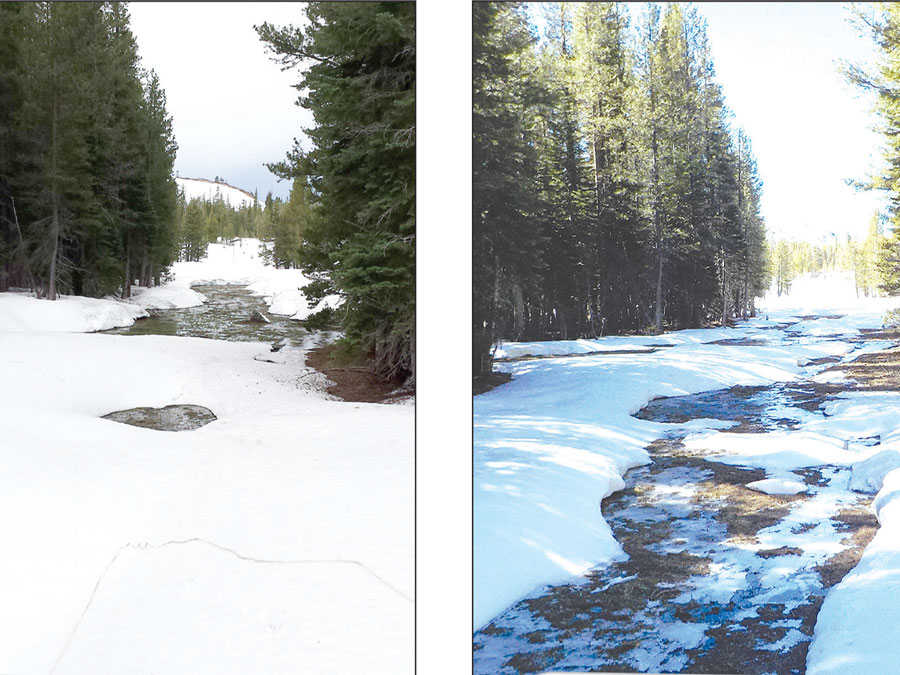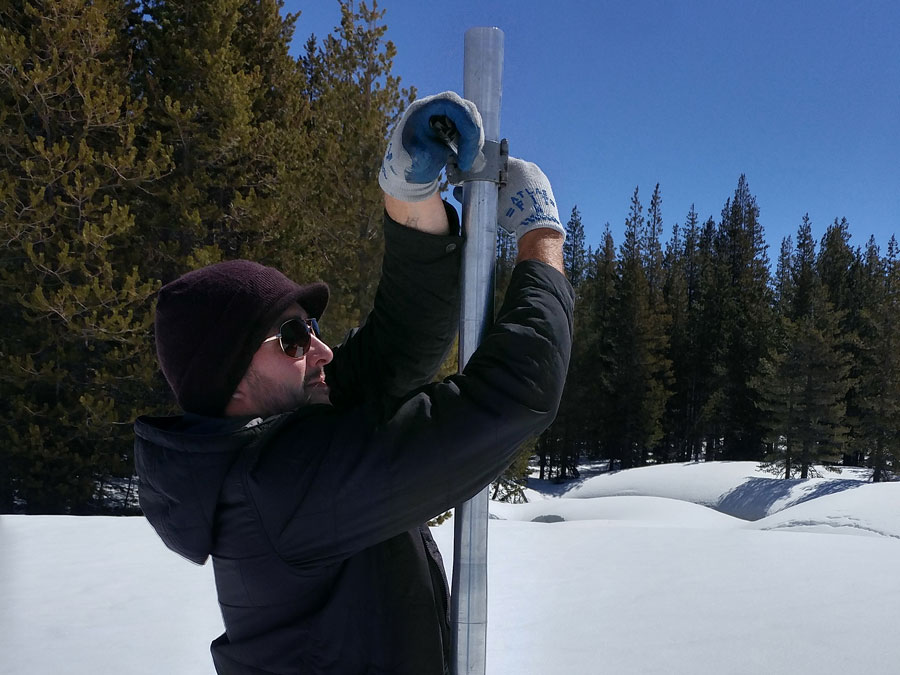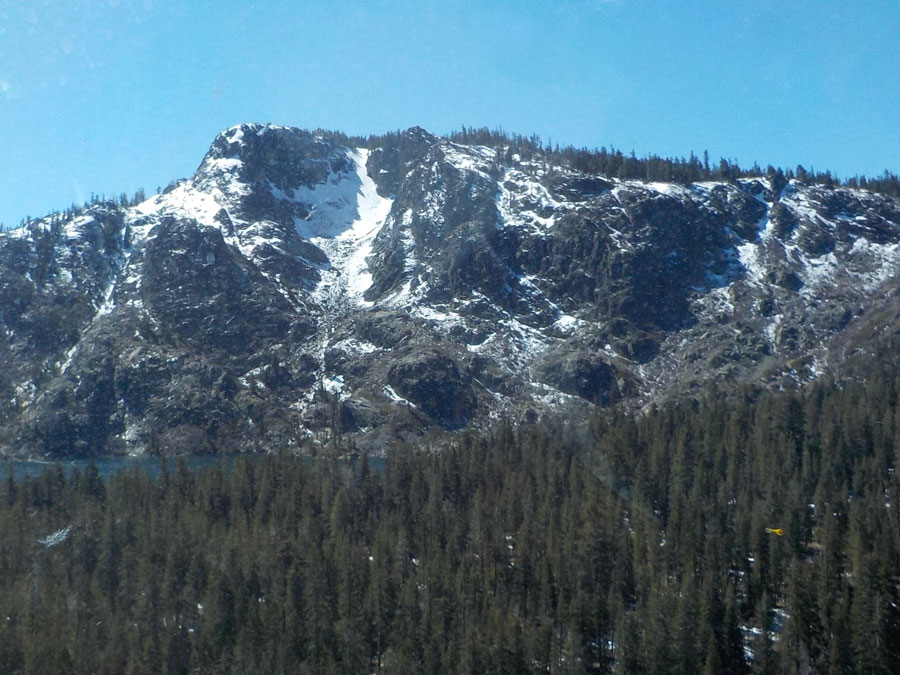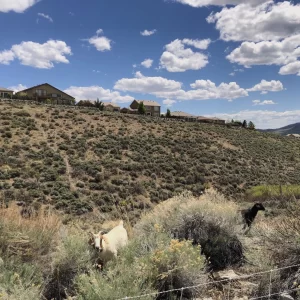
ENGLISH MOUNTAIN, Calif. – On her expeditions measuring Sierra Nevada snowpack, Jessica Erickson catches the scents of sagebrush, cedar, red fir and sugar pine. She spots bear and rabbit tracks, and she hears the calls of mountain chickadees and the trickle of creeks.
An icy wind smacks her cheeks as Erickson measures the snowpack on this mountain in the central Sierra Nevada 40 miles west of Reno. As the senior hydrographer for the Nevada Irrigation District, based in Grass Valley, Calif. Erickson records how deep the snow lies over the mountain’s granite face, and how much water the snow holds. NID’s water managers use these records to forecast how much water they’ll have for residents, ranchers and businesses for the next year. A big-snow winter means plenty for everyone; scanty snow means cutbacks and possibly drought.
Each winter, water agencies across the West take similar stock of their snow. During winter, mountains hold the snow in natural, frozen reservoirs, then in the spring, slowly release meltwater into streams and rivers, filling waiting reservoirs.
But Erickson (who has since retired) and others across the West are documenting a troubling trend: Wintertime temperatures have been rising for two decades. As a result, precipitation more often falls as rain instead of snow, which can be harder to capture. Snowpack is shrinking. In the Great Basin, snowpack supplies as much as 75 percent of fresh water and slakes an estimated 60 million people. Water managers and the people they serve are trying to adapt.
“Going forward, it is likely to become more difficult to store and manage municipal, agricultural and ecological water needs within a warmer climate,” wrote researchers Neil Berg and Alex Hall, of the University of California, Los Angeles, in “Geophysical Research Letters.” March 2017.

Snowpack: One-fourth the size by 2100
Western water supply systems were built on the assumption that snowpack’s frozen reservoir would store water all winter long. The Nevada Irrigation District, on the California side of the Sierra Nevada, is one of many water agencies that depend directly on that historic pattern to supply water to customers. Here’s how that cycle worked:
In October, NID’s reservoirs wait at their lowest levels of the year, pulled down by the demand of summer and fall. Water left in the reservoirs is called “carry-over.”
Then, cold winter storms dump snow on the Sierra Nevada. Below-freezing temperatures keep most of the snow there until late spring. Customer demand perks up in April, when the irrigation season starts, and NID uses reservoir water to supply that demand.
As reservoir water flows out over late spring and summer, snowpack slowly melts and refills the reservoirs. Snowmelt peaks in June. Newly filled reservoirs supply customers into October, when demand slows down again and the reservoir levels drop, NID’s Operations Manager Chip Close said.
This cycle across the Sierra Nevada historically has supplied roughly 60 percent of California’s developed water, state officials said.

New normal: Less water “carried over”
Climate change, however, is changing that cycle. The loss of snowpack “foreshadows major future impacts on the state’s water supplies,” said University of Arizona researcher Soumaya Belmecheri.
Like water agencies across the West, managers at NID already see the impacts on their operations. First, wintertime precipitation falls as rain instead of snow. Rain fills reservoirs as early as February. When snow does come, it’s coming later in the season.
Second, “the melt is happening earlier by two to three months,” Sommers said. “It’s coming off (the mountains) earlier and faster.”
But, “there’s little agricultural demand and little treated-water demand” during winter and early spring to use that early snowmelt, Sommers added. “If our reservoirs are full and there’s no demand, we spill that water.”
By the time customer demand picks up in April and draws down the reservoirs, little snowmelt remains to backfill those lakes.
Within this new normal, Water Resources Superintendent Sue Sindt has to figure out how to keep water flowing to her customers. To fill customer demand and fulfill allocation obligations, Sindt draws down the reservoirs further.
By the end of the irrigation season in October, the water that’s left – called “carry-over storage” – will be less. That’s a critical change, Sindt said.
“Absent knowing what the following winter is going to be like, carry-over storage is the only known water supply we have” going into the next year, she added.
And because the next year could come up dry, maintaining as much carry-over as possible is important for maintaining water security for the whole community, Sindt said.

As climate warms, water is lost downstream
These changes impact more than water for drinking and for agricultural and industrial use.
When wintertime precipitation falls as rain instead of snow, much of it comes rushing down the mountains, threatening aging water infrastructure across the West. Warm winter storms caused flooding along the Truckee River and elsewhere in winter 2019.
In California, wintertime rains and early snowmelt led to the failure of a spillway at Oroville Dam and the evacuation of 180,000 people in 2017. UCLA climate scientist Daniel Swain attributed that flooding to climate change. “If we had had (that) same winter 30 or 40 years ago, a lot more of that (precipitation) probably would have been snow,” Swain said.
Water managers become “climate ready”
Reliance on one source of water – melting snow – has pushed NID toward a series of measures to become “climate ready,” said General Manager Remleh Scherzinger.
Adaptations include infrastructure repairs and improvements; and incentives for customers to save water, including mulch programs and the installation of high-tech water meters. The district is funding programs to thin overgrown forests and restore degraded areas of the watershed, improving both the environment and the ability of watershed soils to store water.
In 2013, NID became the first water agency in the nation to propose building a new reservoir with the stated purpose of responding to climate change. The proposed Centennial Reservoir on the Bear River has stirred opposition from local environmental groups and indigenous tribes, and its fate is uncertain. Nevertheless, water district leaders remain committed to becoming what they call “climate ready.”
“It’s extraordinarily important to the district to be flexible in its operations, both now and into the future, given the uncertainty of climate change,” Scherzinger said.






